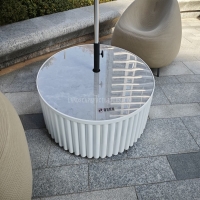Welcome to the website for landscape facilities products and knowledge.
Are there any ergonomic considerations in the table’s height and design?
Absolutely. The height and design of a table are foundational to ergonomic well-being, directly impacting posture, comfort, and long-term health. An improperly sized table can be a primary source of neck, shoulder, and back strain.
The cornerstone of ergonomic table height is achieving a neutral posture. When seated, your elbows should rest comfortably at your sides, forming an angle between 90 and 110 degrees, with your forearms parallel to the floor. This position prevents overreaching or hunching your shoulders. Your thighs should be parallel to the floor, with your feet resting flat, ensuring proper blood circulation. A table that is too high forces shoulder elevation, while one that is too low promotes a slumped, kyphotic spine.
Beyond static height, adjustability is the gold standard. A high-quality, adjustable-height desk, whether sit-stand or traditional, accommodates users of different statures and allows for posture variation throughout the day. The ideal desk surface should also be spacious enough to hold your monitor at arm's length, with the top of the screen at or slightly below eye level.
Design elements are equally critical. A rounded or waterfall front edge minimizes pressure on the wrists and forearms, reducing the risk of conditions like carpal tunnel syndrome. Furthermore, cable management systems and dedicated spaces for peripherals contribute to a clutter-free environment, which reduces unnecessary twisting and reaching.
In conclusion, an ergonomic table is not a luxury but a necessity for a sustainable and healthy workspace. Prioritizing correct height, adjustability, and thoughtful design is a direct investment in your physical comfort and productivity.
Related search:

Recommendation
Round metal tube border design table with tempered glass or granite countertop on the top.